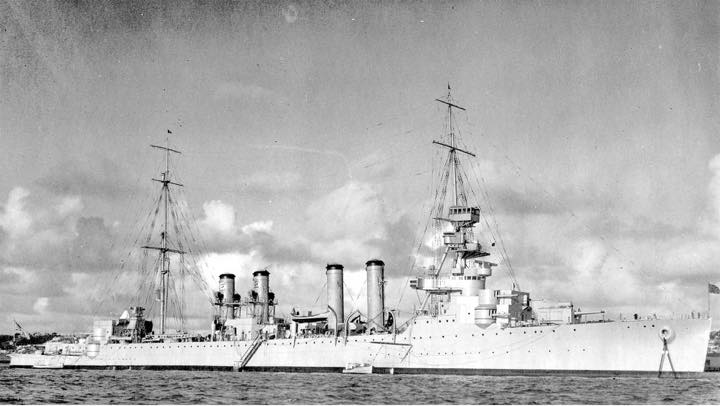USS Omaha CL-4

Omaha II (CL-4: dp. 7, 050; 1. 555'6"; b. 55'4"; dr. 20'10"; s. 34.7 k.; cpl. 458; a. 12 6", 4 3", 6 21" tt.; cl. Omaha)
Omaha (CL~4) was laid down 6 December 1918 by the Todd SB ~ DD Co., Tacoma, Wash., launched 14 December 1920; sponsored by Miss Louise Bushnell White, and commissioned 24 February 1923, Capt. David C. Hanrahan in command.
Following her commissioning, Omaha joined the Atlantic Fleet under peace time conditions. At this time her primary mission was training, and she proved to be very capable by consistently winning fleet awards in gunnery and eommunieations. She made many ports-of-call throughout the Mediterranean and Caribbean during her peacetime cruises, displaying the Stars and Stripes.
Just prior to the U. S. entry into World War II, on 6 November 1941, while on neutrality patrol with Somers (DD-381) in mid-Atlantic near the Equator, Omaha sighted a vessel which aroused much suspicion by her actions. Refusing to satisfactorily identify herself, and taking evasive actions, the stranger was ordered to heave to. She flew the American flag and carried the name Willmoto of Philadelphia on her stern.
As Omaha's crew dispatched a boarding party, the freighter's crew took to life boats and hoisted a signal which indicated that the ship was sinking. When the Omaha party pulled alongside they could hear explosions from within the hull, while one of the fleeing crewmen shouted "This is a German ship and she is sinking." In short order the men of the Omaha, in spite of extreme dangers, had salvaged the vessel, rendered her safe and had her underway for Puerto Rico. The freighter, as it turned out, was the German ship Oder~wld, and her capture was one of the great dramas of American seamanship.
After the United States entered the war, Omaha continued her South Atlantic patrol, instructed to stop Nazi blockade runners. While patrolling out of a base in Brazil, on 4 January 1944, with Jouett (I)D-396), she spotted a ship which immediately showed signs of being scuttled. The ship's crew took to the boats and she began settling by the stern. The following day another ship was sighted and its crew set her afire. Oma7u~ opened fire and the vessel disappeared beneath the waves. Both ships carried cargos of rubber which the Germans desperately needed.
In March, Omaha proceeded to Naples to prepare for landings in Southern France. On 19 August she protected the flank of the units bombarding Toulon, and three days later took part in the operations that resulted in the surrender of the German garrison on the island of Porquerolles.
Omaha was present at the surrender of Giens on 23 August, and on the 25th she delivered a sustained bombardment on targets in the Toulon area. Shortly thereafter she was detached from the operation and returned to patrol duties. The termination of hostilities (15 August 1945) found her patrolling in the South Atlantic.
Omaha sailed for Philadelphia upon detachment from patrol, arriving 1 September. By 17 October she was slated for retirement, and she decommissioned 1 November 1945. Omaha was struck from the Naval Register 28 November 1945, and scrapped in February 1946 at the Philadelphia Navy Yard.
Omaha earned one battle star for service in World War II.
 >
>